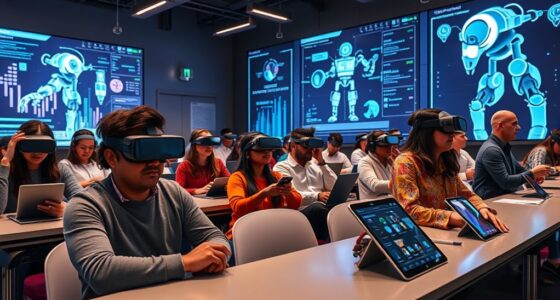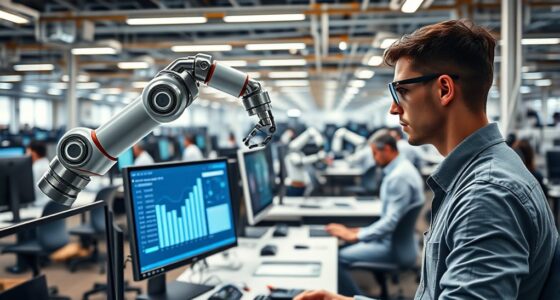Algorithms now act as digital bosses, assigning tasks, monitoring performance, and making decisions you once expected from a human manager. They aim to improve productivity, standardize decisions, and reduce bias, but can also create stress and mistrust if not properly managed. Transparency, ethical use, and oversight are essential for responsible integration. If you want to understand how this shift affects your work and well-being, keep exploring how human-AI collaboration is evolving.
Key Takeaways
- Algorithms automate managerial tasks, monitor employee performance, and make decisions to improve productivity and consistency.
- AI-driven management can personalize employee benefits and support, enhancing engagement and emotional well-being.
- Ethical considerations, transparency, and oversight are crucial to prevent biases and ensure responsible algorithmic management.
- Human-AI collaboration requires clear role definitions, ongoing training, and trust-building to maximize effectiveness.
- Vigilant oversight, including ethical hacking and governance, helps identify vulnerabilities and maintain a supportive, fair work environment.
The Rise of Algorithmic Management in the Workplace
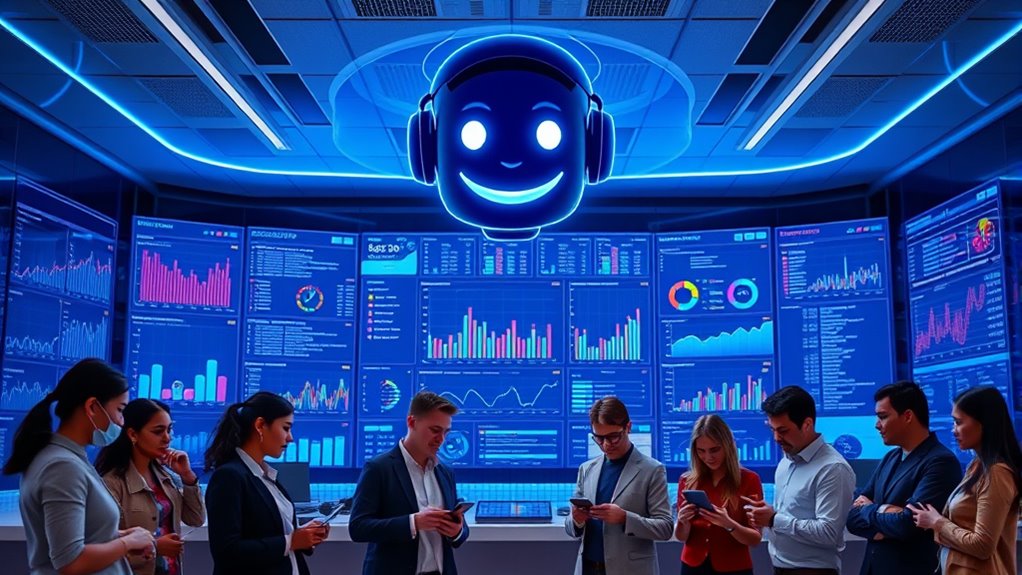
The rise of algorithmic management in the workplace reflects a significant shift toward automating traditional managerial tasks through software and AI. You’re likely to see systems that track data to assign, monitor, and evaluate work, aiming to boost productivity and consistency. These tools help standardize decisions, reduce bias, and cut administrative burdens for managers, making processes more efficient. Algorithmic management is now used worldwide across various industries, affecting both managerial roles and worker experiences. Despite its benefits, such as improved decision quality and job satisfaction for some managers, it also raises concerns about transparency, accountability, and worker well-being. It can fully or partially automate managerial functions within firms, and as adoption grows, organizations face challenges in establishing governance and ensuring ethical, responsible use of these powerful technologies. Incorporating performance metrics can further refine decision-making processes and align employee goals with organizational objectives. Additionally, understanding employee interactions with algorithms can help organizations address potential biases and improve system fairness. Moreover, considering the diverse designs of these systems can enhance their adaptability to different work environments and employee needs. Recognizing the importance of AI security in safeguarding sensitive employee data is also crucial as these systems become more integrated into daily operations. As these systems evolve, ongoing training and oversight are essential to ensure ethical and effective implementation.
How AI Is Transforming HR and Workforce Planning
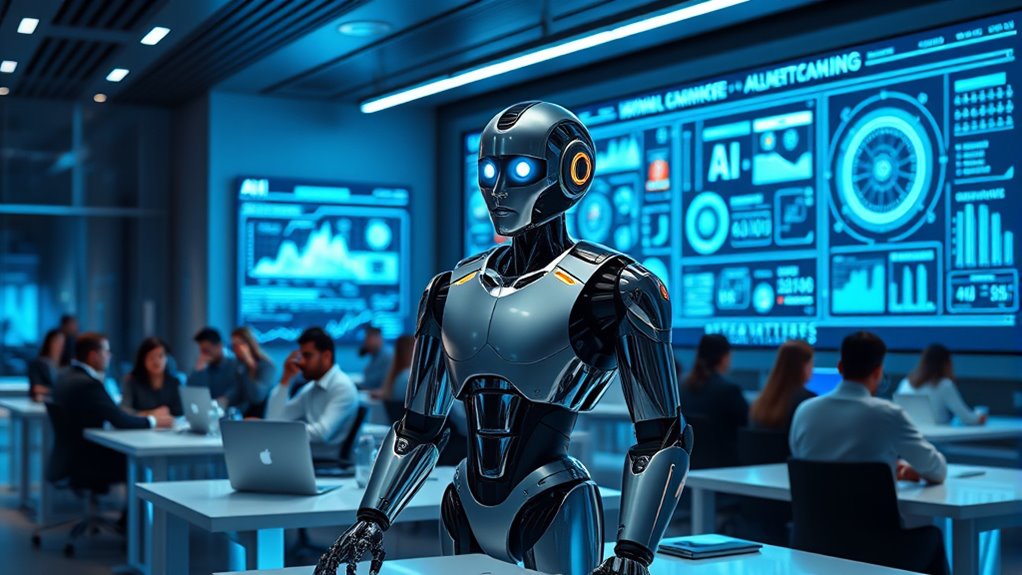
AI is revolutionizing HR and workforce planning by enabling organizations to analyze data more effectively and make smarter decisions. You can now leverage AI-driven analytics to identify trends and optimize resource allocation. Predictive modeling forecasts future staffing needs, allowing you to plan proactively. Automated workflows handle routine HR tasks, freeing your team for strategic initiatives. To visualize this:
- Imagine AI analyzing vast employee data sets instantly, revealing hidden patterns.
- Picture AI models predicting workforce shortages months ahead, guiding recruitment.
- Envision AI automating onboarding and compliance tasks, reducing manual effort.
- Data processing capabilities allow organizations to gain deeper insights into workforce dynamics and make more informed strategic choices. Additionally, integrating data privacy and ethical considerations ensures responsible use of employee information while maximizing AI benefits. Incorporating natural language processing can further enhance communication and feedback analysis within HR systems. Furthermore, advancements in robotics automation are increasingly supporting HR functions by streamlining administrative processes and reducing errors. Recognizing the importance of accurate data is essential for effective AI implementation in HR. These tools help you make data-driven decisions in real-time, ensuring your workforce remains agile and aligned with organizational goals. AI transforms HR from reactive to proactive, shaping a smarter, more efficient workplace.
Personalization and Benefits: AI’s Impact on Employee Satisfaction

Advances in AI are reshaping how benefits are tailored to individual employees, directly impacting satisfaction and engagement. By analyzing diverse factors like generational, cultural, geographic, and economic data, AI personalizes benefits to meet specific needs. This targeted approach increases engagement by aligning offerings with what employees value most, reducing underutilization. Personalized benefits also promote equity across diverse workforces, ensuring everyone receives relevant support. AI-driven personalization delivers better ROI by cutting waste from generic programs. It also helps employees understand complex benefits through clear, conversational explanations and comparison tools, leading to better decision-making. With AI virtual assistants available 24/7, employees get immediate support, increasing confidence and satisfaction. Incorporating eye patch benefits into wellness programs exemplifies how personalized health solutions can enhance employee well-being. Additionally, leveraging personal development techniques such as goal setting and mindfulness can further improve overall employee morale. Understanding the role of attention in creative practice can inspire organizations to foster more focused and innovative work environments. Implementing space maximization strategies in benefits administration can streamline processes and improve user experience. Recognizing the importance of custom vehicle tuning can inspire innovative approaches to personalized support, fostering a more engaged and satisfied workforce. Sharing data enables even more tailored experiences, boosting participation and trust in benefits programs.
Challenges and Concerns Surrounding Algorithmic Oversight
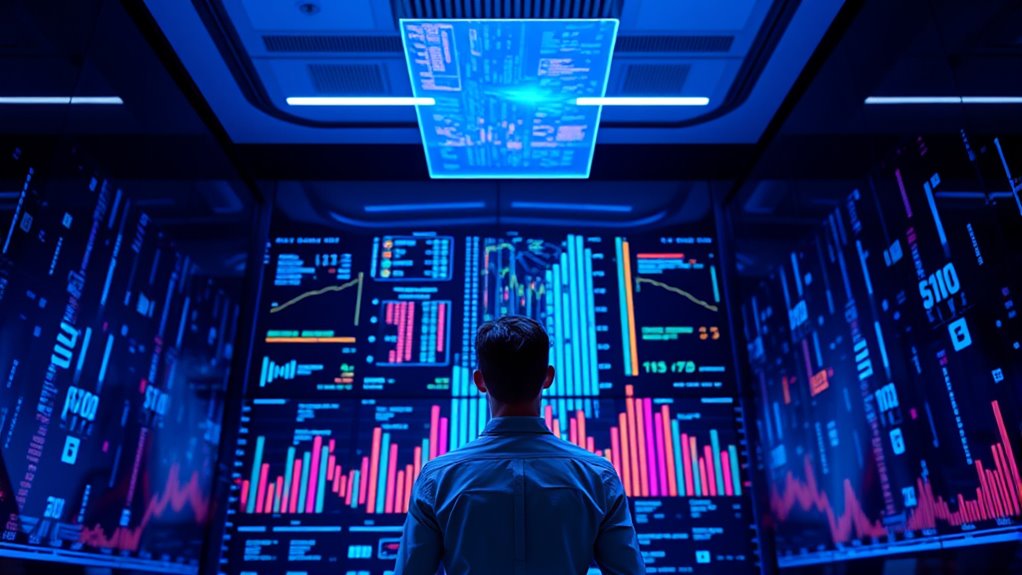
As algorithmic oversight becomes more prevalent in workplaces, concerns about transparency, accountability, and fairness grow louder. You might struggle to understand how decisions are made, making it hard to challenge or question systems that lack clear responsibility. Imagine:
- Trying to track who’s responsible when an unfair performance rating appears.
- Facing opaque algorithms that seem to operate without logic or explanation.
- Feeling overwhelmed by constant surveillance, with your actions scrutinized and controlled.
- Recognizing that a lack of algorithmic transparency can undermine trust and lead to misinterpretations of data.
These issues can lead to power imbalances, stress, and mistrust. Surveillance intensifies, and workers often feel controlled rather than supported. Without proper oversight or regulations, biases can go unchecked, worsening inequalities and impacting your health and job satisfaction. Algorithmic tools are increasingly adopted in various sectors globally, which amplifies the importance of establishing clear guidelines and safeguards. Additionally, understanding the personality traits of those involved can help identify potential biases or issues in decision-making processes, especially as color psychology influences perceptions and judgments in the workplace. Recognizing the emotional support needs of employees can also foster a healthier work environment and mitigate stress caused by algorithmic management. Incorporating ethical hacking principles can aid organizations in identifying vulnerabilities within their oversight systems before they are exploited or cause harm.
The Future of Human-AI Collaboration in Work Environments
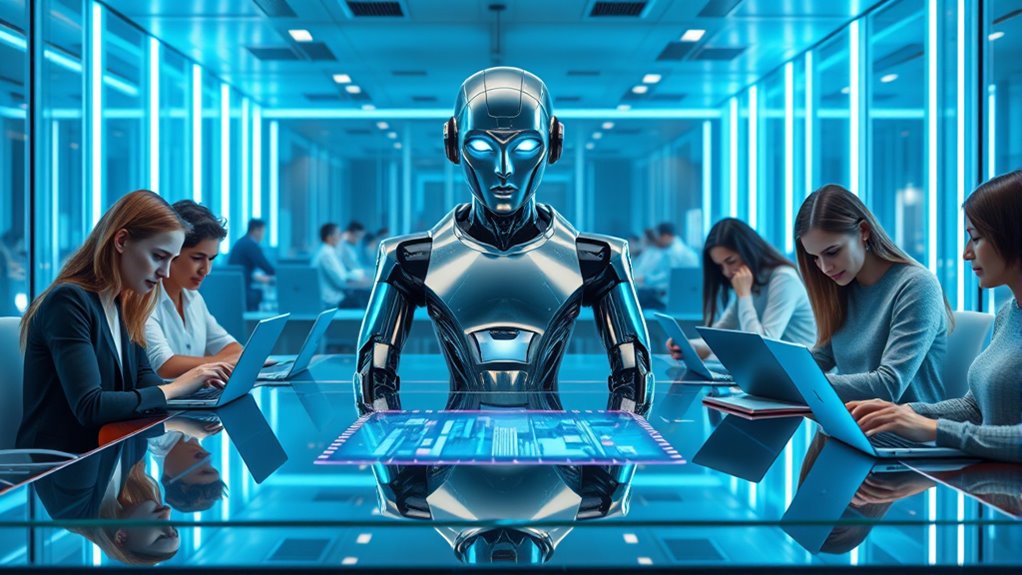
With growing concerns about transparency and fairness in algorithmic oversight, organizations are now exploring how human-AI collaboration can reshape work environments. You’ll see AI boosting productivity by automating routine tasks and supporting strategic decisions. Companies are making strategic investments to release AI’s full potential, emphasizing clear role definitions for humans and machines. Measuring skills—both soft and technical—becomes essential to maximize collaboration. Here’s a quick look at future trends:
| Trend | Impact | Example |
|---|---|---|
| Collaboration Importance | Enhances productivity, ensure value | Joint AI-human projects |
| Skills Measurement | Quantifies soft and hard skills | Performance metrics |
| Role Definition | Clarifies responsibilities | Task allocations |
| Lifelong Learning | Adapts workforce to AI changes | Continuous training |
| Ethical Deployment | Guarantee responsible AI use | Transparency initiatives |
As organizations recognize that success depends not just on technology but also on fostering a trusting and inclusive culture, they are increasingly investing in training, ethical guidelines, and transparent communication strategies to ensure responsible AI integration. Emphasizing AI ethics and establishing clear governance frameworks will be critical for sustainable collaboration. Incorporating skills assessment tools can help organizations identify gaps and tailor development programs effectively. This shift promises significant economic and social benefits, making your future workplace smarter and more innovative.
Frequently Asked Questions
How Do Employees Perceive Transparency in Algorithmic Decision-Making?
You likely perceive transparency in algorithmic decision-making as vital for trust and fairness. When algorithms clearly explain how decisions are made, you tend to feel more comfortable and less suspicious, especially if the process seems objective. However, if explanations are vague or missing, you might distrust the system or view it as biased. Overall, transparency helps you understand and accept algorithm-based decisions, fostering a more positive perception.
What Measures Ensure Accountability in Ai-Managed Workplaces?
You might think accountability is complex, but clear roles and responsibilities make it straightforward. Assigning oversight roles like a Chief AI Officer and conducting regular AI audits establish who’s responsible. Transparency measures, such as explainable AI, help you understand decisions. Strengthening safety protocols and ensuring compliance with ethical standards keep the workplace secure and trustworthy. Together, these steps create a responsible AI environment where everyone knows who’s accountable for what.
How Is Worker Health Protected Under Algorithmic Management Systems?
You can safeguard your health under algorithmic management by advocating for clear policies that limit work intensification and monitor workload. Push for transparency about data collection and surveillance practices, and demand adequate breaks and autonomy. Stay informed about your rights, and support regulations that enforce safe working conditions. By speaking up and organizing, you help ensure your well-being is prioritized amidst automated systems.
What Legal Frameworks Govern Ai’s Role in Employment Decisions?
You need to understand that legal frameworks regulate AI in employment decisions to guarantee fairness and prevent discrimination. Laws like Title VII prohibit bias, and agencies like the EEOC provide guidance on disparate impact. States such as Illinois and New York have specific laws requiring transparency, consent, and annual impact assessments. Globally, regions like the EU are developing detailed regulations, and organizations must stay compliant across different jurisdictions to avoid legal risks.
How Can Organizations Balance AI Efficiency With Employee Privacy?
You need to balance AI efficiency with employee privacy by establishing clear policies that regulate data collection and use. Be transparent about how AI systems operate and what data they gather. Educate your team on AI’s benefits and privacy safeguards, and involve them in feedback processes. Prioritize ethical considerations and accountability, ensuring trust and engagement while leveraging AI to boost productivity without compromising individual privacy.
Conclusion
As algorithms take the reins, you’ll find yourself steering new boundaries, embracing smarter systems, and adapting to evolving roles. You’ll experience increased efficiency, personalized benefits, and data-driven decisions. Yet, you’ll also face challenges, questions, and the need for human oversight. Ultimately, you’ll shape the future of work by balancing technology with empathy, embracing collaboration over control, and fostering a workplace where humans and AI grow together, creating a smarter, fairer, and more connected environment.


